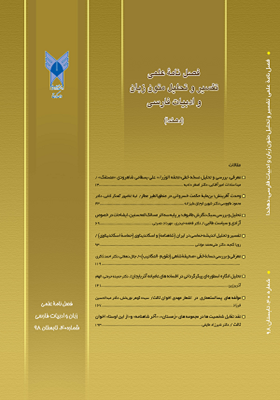نقد تقابل شخصیت ها در مجموعه های «زمستان»، «آخر شاهنامه» و «از این اوستا» اخوان ثالث
محورهای موضوعی : متون زبان و ادبیات فارسی
1 - دانشیار،گروه زبان و ادبیات فارسی، دانشگاه علامه طباطبایی، تهران،ایران
کلید واژه:
چکیده مقاله :
هنرمندان، اندیشه ها و آرمان های خود را در قالب آثار هنری خود بیان می کنند. تقابل شخصیت ها و چگونگی و چرایی آن در انتقال پیام هنرمند به مخاطب، نقش مهمی دارد؛ زیرا قرار گرفتن ویژگی های شخصیتی و فردی متفاوت و گاه متضاد در کنار یکدیگر، سبب برجسته سازی آن ها و تأثیرگذاری بیشتر می شود. در پژوهش پیش رو به روش استقرایی- تحلیلی به نقد تقابل شخصیت ها در مجموعه اشعار زمستان، آخر شاهنامه و از این اوستای مهدی اخوان ثالث در دو زمینۀ محتوایی و ساختاری پرداخته ایم. دستاورد پژوهش، گویای این است که اخوان ثالث در بازنمایی شخصیت ها، به خصوص شخصیت های اصلی به گونه ای تأثیرگذار، آن ها را در مقابل شخصیت های کاملاً متفاوت می آورد، و نیز گاهی یک شخصیت را در ابعاد متفاوتی می نمایاند. شاعر در استفاده از این تقابل، به دنبال ابلاغ پیام های مستقیم و نمادین، تبیین رسالت شاعری و اجتماعی، بیان آرمان های خرد و کلان، و در نهایت بازگویی چه گونگی و چرایی صف آرایی اندیشه ها است. پژوهش در چنین زمینه هایی، ضمن گشودن دریچۀ جدیدی به روی مخاطب اثر هنری، وی را با زوایای اندیشه های شاعر آشنا می کند، می تواند مدخلی برای شناخت بخشی از مؤلّفه های فرهنگ و هنر و اندیشۀ جامعه باشد.
The artists express their paradigms and ideals within the framework of their artistic works. Diversity of characters and their quality and reason may play important role in conveying artist’s message to the audience since juxtaposition of different and sometimes opposite personality and individual traits can cause them to become more prominent with more influence. We have criticized diversity of characters in poetic collections of ‘Winter’, ‘The end of Shahnameh’, and ‘From this Avesta’ written by Mehdi Akhavan Sales in two content and structural fields using inductive- analytical method. The research achievement denotes that in representation of characters, especially the main characters Akhavan Sales puts them versus completely different characters and also sometimes he shows a character in various dimensions. Using such diversity, the poet looks for conveying direct and symbolic messages, interpreting poetic and social mission, expressing micro and macro ideals, and finally restating quality and reason for classification of paradigms. In addition to opening new windows toward audience of artistic work, study on such fields may familiarize him/her with viewpoints of poet’s doctrines and it can be an entry for recognition of some of elements of culture and art and doctrine of community.
مقالات
_||_


